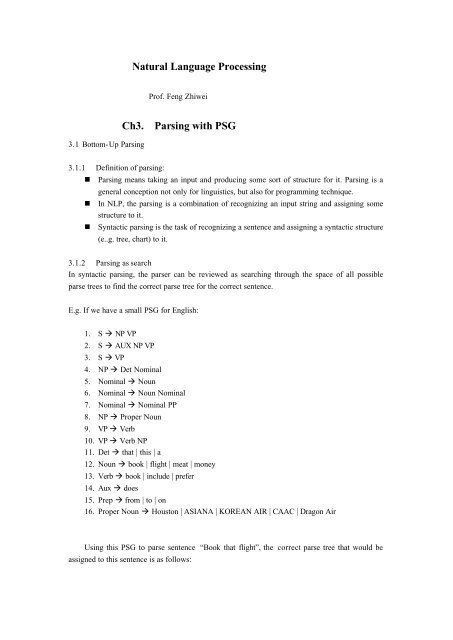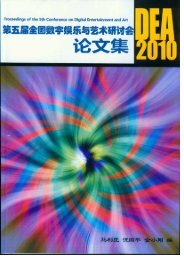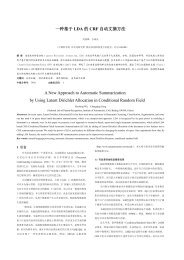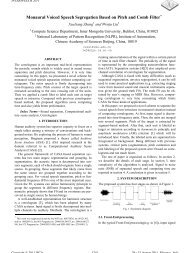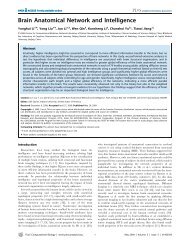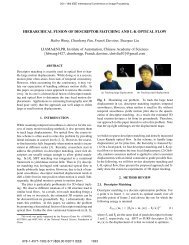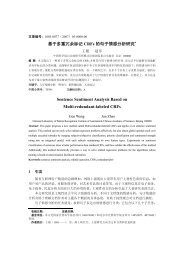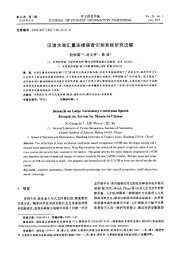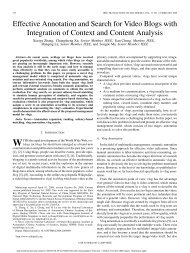Natural Language Processing Ch3. Parsing with PSG
Natural Language Processing Ch3. Parsing with PSG
Natural Language Processing Ch3. Parsing with PSG
Create successful ePaper yourself
Turn your PDF publications into a flip-book with our unique Google optimized e-Paper software.
<strong>Natural</strong> <strong>Language</strong> <strong>Processing</strong><br />
Prof. Feng Zhiwei<br />
3.1 Bottom-Up <strong>Parsing</strong><br />
<strong>Ch3.</strong> <strong>Parsing</strong> <strong>with</strong> <strong>PSG</strong><br />
3.1.1 Definition of parsing:<br />
• <strong>Parsing</strong> means taking an input and producing some sort of structure for it. <strong>Parsing</strong> is a<br />
general conception not only for linguistics, but also for programming technique.<br />
• In NLP, the parsing is a combination of recognizing an input string and assigning some<br />
structure to it.<br />
• Syntactic parsing is the task of recognizing a sentence and assigning a syntactic structure<br />
(e..g. tree, chart) to it.<br />
3.1.2 <strong>Parsing</strong> as search<br />
In syntactic parsing, the parser can be reviewed as searching through the space of all possible<br />
parse trees to find the correct parse tree for the correct sentence.<br />
E.g. If we have a small <strong>PSG</strong> for English:<br />
1. S à NP VP<br />
2. S à AUX NP VP<br />
3. S à VP<br />
4. NP à Det Nominal<br />
5. Nominal à Noun<br />
6. Nominal à Noun Nominal<br />
7. Nominal à Nominal PP<br />
8. NP à Proper Noun<br />
9. VP à Verb<br />
10. VP à Verb NP<br />
11. Det à that | this | a<br />
12. Noun à book | flight | meat | money<br />
13. Verb à book | include | prefer<br />
14. Aux à does<br />
15. Prep à from | to | on<br />
16. Proper Noun à Houston | ASIANA | KOREAN AIR | CAAC | Dragon Air<br />
Using this <strong>PSG</strong> to parse sentence “Book that flight”, the correct parse tree that would be<br />
assigned to this sentence is as follows:
S<br />
VP<br />
Verb<br />
NP<br />
book Det Nominal<br />
that<br />
Noun<br />
Fig. 1 parse tree<br />
flight<br />
Regardless of the search algorithm we choose, there are two kinds of constraints that should<br />
help guide the search.<br />
• Constraint coming from the data: The final parse tree must have three leaves (three<br />
words in the input sentence): “book, that flight”.<br />
• Constraint coming from the grammar: the final parse tree must have one root: S (start<br />
symbol).<br />
These two constraints give rise to the two search strategies:<br />
• Bottom-up search (or data-directed search)<br />
• Top-down search (or goal-directed search)<br />
3.1.3 Bottom-Up <strong>Parsing</strong><br />
In bottom-up parsing, the parser starts <strong>with</strong> the words of the input and tries to build tree from the<br />
words up. The parsing is successful if the parser succeeds in building a tree rooted in the start<br />
symbol S that covers all of the input.<br />
Example:<br />
We use above small <strong>PSG</strong> to parse (Bottom-Up) sentence “Book that flight”<br />
First ply: Book that flight<br />
Second ply: Noun Det Noun Verb Det Noun<br />
Book that flight Book that flight<br />
Third ply: Nominal Nominal Nominal<br />
Noun Det Noun Verb Det Noun<br />
Fourth ply:<br />
NP<br />
Book that flight Book that flight<br />
NP<br />
Nominal Nominal VP Nominal Nominal<br />
Noun Det Noun Verb Det Noun Verb Det Noun<br />
Book that flight Book that flight Book that flight
Fifth ply:<br />
VP<br />
NP NP NP<br />
Nominal Nominal VP Nominal Nominal<br />
Noun Det Noun Verb Det Noun Verb Det Noun<br />
Book that flight Book that flight Book that flight<br />
(Fail !) (Fail !)<br />
Sixth ply:<br />
S<br />
VP<br />
NP<br />
Nominal<br />
Verb Det Noun<br />
Book that flight<br />
Fig. 2 Bottom-Up parser<br />
In sixth ply, the root S covers all the input, our Bottom-Up parsing is success.<br />
We can use Shift-Reduce algorithm to do the parsing.<br />
In the shift-reduce algorithm, the stack is used for information access. The operation methods are<br />
shift, reduce, refuse and accept. In the shift, the symbol waiting to process is move to the top of<br />
stack. In the reduce, the symbol on stack top is replaced by RHS of grammar rule, if the RHS of<br />
the rule is matched <strong>with</strong> the symbol on stack top. If the input string is processed, and the symbol<br />
on stack top becomes S (initial symbol in the string), then the input string is accepted. Otherwise,<br />
it is refused.<br />
Following is the shift-reduce process of sentence “Book that flight”<br />
Stack Operation the rest part of input string<br />
Book that flight<br />
++Book shift that flight<br />
Noun reduce by rule12 that flight<br />
Noun that shift flight<br />
Noun Det reduce by rule 11 flight<br />
Noun Det flight shift <br />
Noun Det Noun reduce by rule 12 <br />
Noun Det Nominal reduce by rule 5 <br />
Noun NP reduce by rule 4
[Backtracking to ++]<br />
+++ Verb reduce by rule 13 that flight<br />
VP reduce by rule 9 that flight<br />
VP that shift flight<br />
VP Det reduce by rule 11 flight<br />
VP Det flight shift <br />
VP Det Noun reduce by rule 12 <br />
VP Det Nominal reduce by rule 5 <br />
VP NP reduce by rule 4 <br />
[Backtracking to +++]<br />
Verb that shift flight<br />
Verb Det reduce by rule 11 flight<br />
Verb Det flight shift <br />
Verb Det Noun reduce by rule 12 <br />
Verb Det Nominal reduce by rule 5 <br />
Verb NP reduce by rule 4 <br />
VP reduce by rule 10 <br />
S reduce by rule 3 <br />
3.2 Top-Down <strong>Parsing</strong><br />
[Success !]<br />
3.2.1 The process of Top-Down <strong>Parsing</strong><br />
A top-down parser searches for a parse tree by trying to build from the root node S down to the<br />
leaves. The algorithm starts symbol S. The next step is to find the tops of all trees which can start<br />
<strong>with</strong> S. Then expend the constituents in new trees. etc.<br />
If we use above small <strong>PSG</strong> to parse (Top-Down) sentence “Book that flight”,, first 3 ply will be as<br />
follows:<br />
First ply:<br />
Second ply: S S S<br />
S<br />
Third ply:<br />
NP VP Aux NP VP VP<br />
S S S S S S<br />
NP VP NP VP Aux NP VP Aux NP VP VP VP<br />
Det Nom PropN Det Noun PropN V NP V<br />
(fail !) (fail !) (fail !) (fail !) (fail !)<br />
In this case, only the fifth parse tree will match the input sentence.<br />
S<br />
VP<br />
Fourth ply:<br />
Verb<br />
NP
S<br />
VP<br />
Verb<br />
NP<br />
Book<br />
Fifth ply:<br />
S<br />
S<br />
VP<br />
VP<br />
Verb NP Verb NP<br />
Book ProperNoun book Det Noninal<br />
(fail !)<br />
Sixth ply:<br />
S<br />
VP<br />
Verb<br />
NP<br />
Book Det Nominal<br />
That<br />
Seventh ply:<br />
S S S<br />
VP VP VP<br />
Verb NP Verb NP Verb NP<br />
Book Det Nominal Book Det Nominal Book Det Nominal<br />
that Nominal PP that Noun Nominal that Noun<br />
(fail !) ( fail !)<br />
Eighth ply:
S<br />
VP<br />
Verb<br />
NP<br />
Book Det Nominal<br />
That<br />
Noun<br />
[Success !]<br />
flight<br />
Fig. 3 Top-Down parsing<br />
The search process of the sentence ”book that flight”:<br />
++S<br />
Searching goal Rule The rest part of input string<br />
Book that flight<br />
+NP VP 1 Book that flight<br />
Det Nom VP 4 Book that flight<br />
[backtracking to +]<br />
PropN VP 8 Book that flight<br />
[backtracking to ++]<br />
Aux NP VP 2 Book that flight<br />
[backtracking to ++]<br />
Book that flight<br />
+++VP 3 Book that flight<br />
Verb 9 Book that flight<br />
<br />
[backtracking to +++]<br />
Book that flight<br />
++++Verb NP 10 Book that flight<br />
PropN 8 that flight<br />
[backtracking to ++++]<br />
Det Nominal 4 that flight<br />
+++++ Nominal flight<br />
++++++Nominal PP 7 flight<br />
Noun Nominal PP 6 flight<br />
Nominal PP<br />
<br />
[backtracking to ++++++]<br />
Noun PP 5 flight<br />
PP<br />
<br />
[backtracking to +++++]<br />
Noun Nominal 6 flight<br />
Nominal<br />
<br />
[backtracking to +++++]<br />
Noun 5 flight
[Success ! ]<br />
3.2.2 Comparing Top-Down and Bottom-Up <strong>Parsing</strong><br />
• Top-Down strategy never wastes time exploring trees that cannot result in an S, since it<br />
begins by generating just those trees. This means it never explores subtrees that cannot<br />
find a place in some S-rooted tree. By contrast, In the bottom-up strategy, trees that have<br />
no hope of leading to an S are generated <strong>with</strong> wild abandon. it will waste effort<br />
• Top-Down strategy spends considerable effort on S trees that are not consistent <strong>with</strong> the<br />
input. It can generate trees before ever examining the input. Bottom-Up never suggest<br />
trees that are not locally grounded in the actual input.<br />
Neither of these approaches adequately exploits the constraints presented by the grammar and the<br />
input words.<br />
3.3.3 A basic Top-Down parser<br />
3.3.3.1 left-corner: We call the first word along the left edge of a derivation the left-corner of the<br />
tree.<br />
e.g. VP VP<br />
NP<br />
Nom<br />
Verb Det Noun Noun Verb Det Noun Noun<br />
prefer a morning flight prefer a morning flight<br />
Fig. 4 left-corner<br />
In Fig. 4, the node “verb”and the node “prefer”are both left-corner of VP.<br />
Formally, we can say that for non-terminals A and B, B is a left-corner of A if the following<br />
relation holds:<br />
A à B<br />
<br />
<br />
<br />
The parser should not consider any grammar rule if the current input cannot serve as the first word<br />
along the left edge of some derivation from the rule.<br />
3.2.3 Bottom-Up Filtering<br />
We can set up a table that list all the valid left-corner categories (it is part of speech, POS) for each<br />
non-terminal (e.g. S, VP, NP, etc) in the grammar. When a rule is considered, the table entry for<br />
the category (POS) that starts the right hand side of the rule in consulted. If it fails to contain any<br />
of the POS associated <strong>with</strong> the current input then the rule is eliminated from consideration. In this<br />
case, this table can be regarded as a bottom-up filter.<br />
For our small Grammar, the left-corner table is as follows:<br />
Non-terminal<br />
Left-corner<br />
S<br />
NP<br />
Nominal<br />
VP<br />
Det, Proper Noun, Aux, Verb<br />
Det, Proper Noun<br />
Noun<br />
Verb
Fig. 5 left-corner table<br />
Using this left-corner table, the process of sentence “book that flight”will become simple and<br />
quick. The process is as follows:<br />
First ply:<br />
S S S<br />
VP NP VP Aux NP VP<br />
<br />
Verb NP Det Nominal Book<br />
<br />
Book<br />
Book<br />
[Fail !] [Fail !]<br />
Fig. 5<br />
Verb is the left-corner of S. “Det”and “Aux”can not match <strong>with</strong> “Book”.<br />
Second ply:<br />
S<br />
VP<br />
Verb<br />
NP<br />
Book Det Nominal<br />
that<br />
Fig. 6<br />
Det is the left-corner of NP.<br />
Third ply:<br />
S<br />
VP<br />
Verb<br />
NP<br />
Book Det Nominal<br />
That<br />
Noun<br />
Fig. 7<br />
flight
Noun is the left-corner of Nominal.<br />
The Top-Down parsing process using left-corner filter is as follows:<br />
Searching goal Rule The rest part of input string<br />
S<br />
Book that flight<br />
+ VP 3 Book that flight<br />
Verb 9 Book that flight<br />
<br />
<br />
Verb NP 10 Book that flight<br />
NP<br />
that flight<br />
Det Nominal 4 that flight<br />
Nominal<br />
flight<br />
Noun 5 flight<br />
<br />
<br />
3.3 Problems <strong>with</strong> Top-Down Parser<br />
3.3.1 Left-recursion:<br />
In top-down, depth-first, left-to-right parser, It may dive down an infinitely deeper path<br />
never return to visit space if it use the left-recursive grammar.<br />
Formally, a grammar is left-recursive if it contains at least one non-terminal A, such that ,<br />
A à A and <br />
<br />
<br />
<br />
A more obvious and common case of left-recursion in natural language grammar involves<br />
immediately left-recursive rules. The left-recursive rules are rules of the form A à A, where the<br />
first constituent of the RHS is identical to the LHS.<br />
E.g.<br />
NP à NP PP<br />
VP à VP PP<br />
S à S and S<br />
A left-recursive non-terminal can lead a top-down, depth-first, left-to-right parser to recursively<br />
expand the same non-terminal over again in exactly the same way, leading to an infinite expansion<br />
of the trees.<br />
E.g. if we have the left recursive rule NP à NP PP as first rule in our small grammar, we may get<br />
the infinite search as following:<br />
S è S è S è S<br />
NP VP NP VP NP VP
NP PP NP PP<br />
3.3.2 Structure ambiguity<br />
NP<br />
Fig. 8 infinite search .<br />
Structure ambiguity occurs when the grammar assigns more than one possible parse to sentence.<br />
Three common kinds of structure ambiguities are attachment ambiguity, coordination ambiguity<br />
and noun-phrase bracketing ambiguity.<br />
<br />
<br />
<br />
<br />
<br />
<br />
<br />
<br />
<br />
à<br />
<br />
<br />
<br />
<br />
<br />
<br />
<br />
<br />
<br />
<br />
<br />
<br />
<br />
<br />
<br />
<br />
<br />
<br />
<br />
<br />
<br />
<br />
<br />
<br />
<br />
<br />
<br />
à<br />
<br />
<br />
<br />
<br />
à<br />
<br />
<br />
<br />
<br />
à<br />
<br />
<br />
PP
à<br />
<br />
<br />
<br />
<br />
<br />
<br />
<br />
à<br />
<br />
<br />
<br />
<br />
<br />
<br />
<br />
<br />
<br />
<br />
<br />
<br />
<br />
<br />
<br />
1<br />
1<br />
n +<br />
<br />
!<br />
1)<br />
1)...(<br />
(2<br />
2<br />
n<br />
n<br />
n<br />
n +<br />
−<br />
<br />
<br />
<br />
<br />
<br />
<br />
<br />
<br />
<br />
<br />
<br />
<br />
<br />
<br />
<br />
<br />
<br />
<br />
<br />
<br />
<br />
<br />
<br />
<br />
<br />
<br />
<br />
<br />
<br />
<br />
<br />
<br />
<br />
<br />
<br />
<br />
<br />
<br />
“<br />
”<br />
“<br />
”<br />
<br />
“<br />
”<br />
<br />
<br />
<br />
<br />
<br />
<br />
“<br />
”<br />
<br />
“<br />
”<br />
<br />
<br />
<br />
<br />
<br />
<br />
<br />
<br />
‘<br />
’
à<br />
<br />
<br />
<br />
<br />
<br />
à<br />
<br />
’ ’<br />
<br />
<br />
’ ’<br />
<br />
à ’ ’<br />
<br />
<br />
<br />
<br />
<br />
à<br />
<br />
<br />
<br />
<br />
<br />
<br />
<br />
<br />
<br />
<br />
<br />
<br />
<br />
<br />
<br />
<br />
<br />
<br />
à<br />
<br />
<br />
à<br />
3.3.3 Inefficient re-parsing of sub-tree<br />
The parser often builds valid trees for portions of the input, then discards them during<br />
backtracking, only to find that it has to rebuild them again. The re-parsing of sub-tree is inefficient<br />
E,g. The noun phrase “a flight from Beijing to Seoul on ASIANA”, its top-down parser process is<br />
as follows:<br />
NP<br />
Nom<br />
Det<br />
Noun<br />
A flight from Beijing to Seoul on ASIANA
NP<br />
NP<br />
PP<br />
Nom<br />
NP<br />
Det Noun Prep Prop-Noun<br />
A flight from Beijing to Seoul on ASIANA<br />
NP<br />
NP<br />
NP PP PP<br />
Nom NP NP<br />
Det Noun Prep Prop-Noun Prep Prop-Noun<br />
A flight from Beijing to Seoul on ASIANA<br />
NP<br />
NP<br />
NP<br />
NP PP PP PP<br />
Nom NP NP NP<br />
Det Noun Prep Prop-Noun Prep Prop-Noun Prep Prop-Noun<br />
A flight from Beijing to Seoul on ASIANA<br />
Fig. 11 Reduplication effort<br />
Because of the way the rules are consulted in our top-down parsing, the parser is ;ed first to<br />
small parse trees that fail because they do not cover all the input. These successive failures trigger<br />
backtracking events which lead to parses that incrementally cover more and more of the input. In<br />
the backtracking, reduplication of work arises many times. Except for its topmost component,<br />
every part of the final tree is derived more than once in the backtracking process.
Component<br />
reduplication times<br />
A flight 4<br />
From Beijing 3<br />
To Seoul 2<br />
On ASIANA 1<br />
A flight from Beijing 3<br />
A flight from Beijing to Seoul 2<br />
A flight from Beijing to Seoul on ASIANA 1<br />
Similar example of wasted effort also exists in the bottom-up parsing.<br />
3.4 Some Algorithms<br />
3.4.1 Earley algorithm<br />
In order to solve the problems in parsing, Earley (1970) proposes Earley algorithm.<br />
3.4.1.1 Chart and dotted rule<br />
The core of Earley algorithm is chart. For each word position in the sentence, the chart<br />
contains a list of states representing that have been generated so far. By the end of the sentence,<br />
the chart compactly encodes all the possible parses of the input.<br />
The state <strong>with</strong>in each chart contain three kinds of information:<br />
• A sub-tree corresponding to the single grammar rule;<br />
• Information about the progress made in completing this sub-tree;<br />
• Information about the position of the sub-tree <strong>with</strong> respect to the input.<br />
These information is represented by a dotted rule. In the dotted rule, a state position <strong>with</strong> respect<br />
to the input is representd by two numbers indicating where the state begins and where its dot lies.<br />
E.g.<br />
The three rules which using to parser “book that flight”are as follows:<br />
S à VP<br />
NP à Det Nominal<br />
VP à V NP<br />
Some dotted rules of these three rules can be represented as follows:<br />
S à .VP, [0,0]<br />
NP à Det. Nominal, [1,2]<br />
VP à V NP., [0,3]<br />
The state represented by these dotted rules can be expressed by following chart:<br />
VP à V NP.<br />
S à .VP<br />
NP à Det. Nominal
3.4.1.2 Three operators in Early algorithm<br />
• Predictor<br />
The job of predictor is to create new state representing top-down expectations generated during<br />
the parsing process. The predictor is applied to any state that has a non-terminal to the right of the<br />
dot. This application results in the creation of one new state for each alternative expansion of that<br />
non-terminal provided by the grammar. These new states are placed into the same chart entry as<br />
the generated state. They begin and end at the point on the input where the generating state ends.:<br />
E.g. applying the predicator to the state S à .VP, [0,0] results in adding the states VP à .Verb,<br />
[0,0] and VP à .Verb NP, [0,0] to the first chart entry.<br />
• Scanner<br />
When a state has a POS category to the right of the dot, the scanner is called to examine the input<br />
and incorporate a state corresponding to the predicated POS into the chart. This is accomplished<br />
by creating a new state from the input state <strong>with</strong> the dot advanced over the predicted input<br />
category.<br />
E.g. When the state VP à .Verb NP, [0,0] is processed, the Scanner consults the current word in<br />
the input since the category following the dot is a POS. The Scanner then notes that “book”can be<br />
a verb, matching the expectation in the current state. This results in the creation of new state VP<br />
à Verb. NP, [0,1]. The new state is then added to the chart entry that follows the one currently<br />
being processed.<br />
• Completer<br />
The completer is applied to a state when its dot has reached the right end of the rule. Intuitively,<br />
the presence of such a state represents the fact that the parser has successfully discovered a<br />
particular grammatical category over some span of the input. The purpose of the completer is to<br />
find and advance all previously created states that were looking for this grammatical category at<br />
this position in the input. New states are then created by copying the old state, advancing the dot<br />
over expected category and installing the new state in the current chart entry.<br />
E.g. When the state NP à Det Nominal., [1,3] is processed, the completer looks for state ending<br />
at 1 expecting an NP. In the current example, it will find the state VP à Verb. NP, [0,1] created by<br />
the Scanner. This results in the addition of new completer state VP à Verb NP., [0,3].<br />
Martin Kay improved Early algorithm and proposed the fundamental rule of chart parsing.<br />
Strictly, the fundamental rule of chart parsing is as following:<br />
If the chart contains edges and , where A and B are<br />
categories and W1, W2 and W3 are (possibly empty) sequences of categories or words, then<br />
add edge to the chart.<br />
This fundamental rule can be represented by DAG:<br />
<br />
<br />
<br />
<br />
i j k
Fig. 12 fundamental rule of chart parsing<br />
3.4.1.3 An example fro Early algorithm<br />
The state sequence in chart while parsing “book that flight”using our small grammar:<br />
Chart [0]<br />
à .S [0,0] Dummy start state<br />
S à .NP VP [0,0] Predictor<br />
NP à .Det Nominal [0,0] Predictor<br />
NP à .Proper-Noun [0,0] Predictor<br />
S à .Aux NP VP [0,0] Predictor<br />
S à .VP [0,0] Predictor<br />
VP à .Verb [0,0] Predictor<br />
VP à .Verb NP [0,0] Predictor<br />
Chart [1]<br />
Verb à book. [0.1] Scanner<br />
VP à Verb. [0,1] Completer<br />
S à VP. [0,1] Completer<br />
VP à Verb. NP [0,1] Completer<br />
NP à .Det Nominal [1,1] Predictor<br />
NP à .Proper-Noun [1,1] Predictor<br />
Chart [2]<br />
Det à that. [1,2] Scanner<br />
NP à Det. Nominal [1,2] Completer<br />
Nominal à .Noun [2,2] Predictor<br />
Nominal à .Noun Nominal [2,2] Predictor<br />
Chart [3]<br />
Noun à flight. [2,3] Scanner<br />
Nominal à Noun. [2,3] Completer<br />
Nominal à Noun. Nominal [2,3] Completer<br />
NP à Det Nominal. [1,3] Completer<br />
VP à Verb NP. [0,3] Completer<br />
S à VP. [0,3] Completer<br />
Nominal à .Noun [3,3] Predictor<br />
Nominal à .Noun Nominal [3,3] Predictor<br />
In chart [3], the presence of the state representing “flight”leads to completion of NP, transitive VP,<br />
and S. The presence of the state S à VP., [0,3] in the last chart entry means that our parser gets<br />
the success.<br />
3.4.1.4 Retrieving parser trees from a Chart
The Earley algorithm just described is actually a recognizer not a parser. After processing, valid<br />
sentences will leave the state S à ., [0,N] (N is the word number in the sentence)<br />
To return this algorithm into a parser, we must be able to extract individual parses from the chart.<br />
To do this, the representation of each state must be augmented <strong>with</strong> an additional field to store<br />
information about the completed states that generated its constituents.<br />
Recall that the Completer creates new states by advancing older incomplete ones when the<br />
constituent following the dot is discovered. The only change necessary is to have Completer add a<br />
pointer to the older state onto the list of the previous states of the new state. Retrieving a parse tree<br />
from the chart is then merely a recursive retrieval starting <strong>with</strong> the state (or states) representing a<br />
complete S in the final chart entry. Following shows the chart produced by an updated completer.<br />
Chart [0]<br />
à .S [0,0] [] Dummy start state<br />
S1 S à .NP VP [0,0] [] Predictor<br />
S2 NP à .Det Nominal [0,0] [] Predictor<br />
S3 NP à .Proper-Noun [0,0] [] Predictor<br />
S4 S à .Aux NP VP [0,0] [] Predictor<br />
S5 S à .VP [0,0] [] Predictor<br />
S6 VP à .Verb [0,0] [] Predictor<br />
S7 VP à .Verb NP [0,0] [] Predictor<br />
Chart [1]<br />
S8 Verb à book. [0.1] [] Scanner<br />
S9 VP à Verb. [0,1] [S8] Completer<br />
S10 S à VP. [0,1] [S9] Completer<br />
S11 VP à Verb. NP [0,1] [S8] Completer<br />
S12 NP à .Det Nominal [1,1] [] Predictor<br />
S13 NP à .Proper-Noun [1,1] [] Predictor<br />
Chart [2]<br />
S14 Det à that. [1,2] [] Scanner<br />
S15 NP à Det. Nominal [1,2] [S14] Completer<br />
S16 Nominal à .Noun [2,2] [] Predictor<br />
S17 Nominal à .Noun Nominal [2,2] [] Predictor<br />
Chart [3]<br />
S18 Noun à flight. [2,3] [] Scanner<br />
S19 Nominal à Noun. [2,3] [S18] Completer<br />
S20 Nominal à Noun. Nominal [2,3] [S18] Completer<br />
S21 NP à Det Nominal. [1,3]] [S14, S19] Completer<br />
S22 VP à Verb NP. [0,3] [S8, S21] Completer<br />
S23 S à VP. [0,3] [S22] Completer<br />
S24 Nominal à .Noun [3,3] [] Predictor<br />
S25 Nominal à .Noun Nominal [3,3] [] Predictor
The parsing process can be summarized as follows:<br />
S8 Verb à book. [0.1] [] Scanner<br />
S9 VP à Verb. [0,1] [S8] Completer<br />
S10 S à VP. [0,1] [S9] Completer<br />
S11 VP à Verb. NP [0,1] [S8] Completer<br />
S14 Det à that. [1,2] [] Scanner<br />
S15 NP à Det. Nominal [1,2] [S14] Completer<br />
S18 Noun à flight. [2,3] [] Scanner<br />
S19 Nominal à Noun. [2,3] [S18] Completer<br />
S20 Nominal à Noun. Nominal [2,3] [S18] Completer<br />
S21 NP à Det Nominal. [1,3]] [S14, S19] Completer<br />
S22 VP à Verb NP. [0,3] [S8, S21] Completer<br />
S23 S à VP. [0,3] [S22] Completer<br />
The DAG representing the parse is as follows:<br />
S à VP.<br />
.<br />
VP à Verb NP.<br />
NP à Det Nom.<br />
S à Verb. NP<br />
Sà VP,<br />
Nom à Noun. Nom<br />
VP à Verb. NP à Det. Nom Nom à Noun.<br />
Verb àbook. Det à that. Nounà flight.<br />
<br />
<br />
<br />
3.4.1.5 Another examples:<br />
Fig. 13 DAG representing the parsing result<br />
Example-1: Using Early algorithm to parse sentence “Does KA 852 have a first class<br />
section”<br />
<br />
<br />
<br />
à
Chart [0]<br />
à .S [0,0] Dummy start state<br />
S à .NP VP [0,0] Predictor<br />
NP à .Ord Nom [0,0] Predictor<br />
NP à .PrN [0,0] Predictor<br />
S à .Aux NP VP [0,0] Predictor<br />
S à .VP [0,0] Predictor<br />
VP à .V [0,0] Predictor<br />
VP à .V NP [0,0] Predictor<br />
Chart [1]<br />
Aux à does. [0,1] Scanner<br />
S à Aux. NP VP [0,1] Completer<br />
NP à .Ord Nom [1,1] Predictor<br />
NP à .PrN [1,1] Predictor<br />
Chart [2]<br />
PrN à KA 852. [1,2] Scanner<br />
NP à PrN. [1,2] Completer<br />
S à Aux NP. VP [0,2] Completer<br />
VP à .V [2,2] Predictor<br />
VP à .V NP [2,2] Predictor<br />
Chart [3]<br />
V à have. [2,3] Scanner<br />
VP à V. [2,3] Completer<br />
VP à V. NP [2,3] Completer<br />
NP à ..Ord Nom [3,3] Predictor<br />
Chart [4]<br />
Ord à first. [3,4] Scanner<br />
NP à Ord. Nom [3,4] Completer<br />
Nom à .N Nom [4,4] Predictor<br />
Nom à .N. [4,4] Predictor<br />
Nom à .N PP [4,4] Predictor<br />
Chart [5]<br />
N à class. [4,5] Scanner<br />
Nom à N. [4,5] Completer<br />
NP à Ord Nom. [3,5] Completer<br />
VP à V NP. [2,5] Completer<br />
S à Aux NP VP. [0,5] Completer (S’span is 5, 5 < 6)<br />
Nom à N. Nom [4,5] Completer
Nom à .N [5,5] Predictor<br />
Chart [6]<br />
N à section. [5,6] Scanner<br />
Nom à N. [5,6] Completer<br />
Nomà N Nom. [4,6] Completer<br />
NP à Ord Nom. [3,6] Completer<br />
VP à V NP. [2,6] Completer<br />
S à Aux NP VP. [0,6] Completer<br />
[Success !]<br />
The parsing process:<br />
Aux à does. [0,1] Scanner<br />
S à Aux. NP VP [0,1] Completer<br />
PrN à KA 852. [1,2] Scanner<br />
NP à PrN. [1,2] Completer<br />
S à Aux NP. VP [0,2] Completer<br />
V à have. [2,3] Scanner<br />
VP à V. [2,3] Completer<br />
VP à V. NP [2,3] Completer<br />
Ord à first. [3,4] Scanner<br />
NP à Ord. Nom [3,4] Completer<br />
N à class. [4,5] Scanner<br />
N à section. [5,6] Scanner<br />
Nom à N. [5,6] Completer<br />
Nomà N Nom. [4,6] Completer<br />
NP à Ord Nom. [3,6] Completer<br />
VP à V NP. [2,6] Completer<br />
S à Aux NP VP. [0,6] Completer<br />
[Success !]<br />
S à Aux NP VP.<br />
VP à V NP.<br />
NP à Ord Nom.<br />
NP à PrN.<br />
Nom à N Nom.<br />
Nom à N.<br />
Aux à does. PrN à KA852. V à have. Ord à first. N à class. Nà section.<br />
<br />
<br />
<br />
0 1 2 3 4 5 6<br />
Fig. 14
Example-2: using Earley algorithm to parse sentence “It is a flight from Beijing to Seoul on<br />
ASIANA”<br />
The states:<br />
<br />
<br />
<br />
0 1 2 3 4 5 6 7 8 9 10<br />
“It”is a pronoun, so we need to add a new rule in our grammar:<br />
NP à Pron<br />
and<br />
PP à Prep NP<br />
The state sequence is as follows:<br />
Chart [0]<br />
à .S [0,0] Dummy start state<br />
S à .NP VP [0,0] Predictor<br />
NP à .Pron [0,0] Predictor<br />
NP à .PrN [0,0] Predictor<br />
S à .Aux NP VP [0,0] Predictor<br />
S à .VP [0,0] Predicator<br />
VP à .V [0,0] Predicator<br />
VP à .V NP [0,0] Predicator<br />
Chart [1]<br />
Pron à it [0,1] Scanner<br />
NP à Pron. [0,1,] Completer<br />
S à NP. VP [0,1] Completer<br />
VP à .V [1,1] Predictor<br />
VP à .V NP [1,1] Predictor<br />
Chart [2]<br />
V à is. [1,2] Scanner<br />
VP à V. [1,2] Completer<br />
S à NP VP. [0,2] Completer (S’span is 2 < 10)<br />
VP à V. NP [1,2] Completer<br />
NP à .Det Nom [2,2] Predictor<br />
Chart [3]<br />
Det à a. [2,3] Scanner<br />
NP à Det. Nom [2,3] Completer<br />
Nom à N [3,3] Predictor<br />
Nom à .N Nom [3,3] Predictor<br />
Nom à .Nom PP [3,3] Predictor<br />
Chart [4]<br />
N à flight. [3,4] Scanner<br />
Nom à N. [3,4] Completer
NP à Det Nom. [2,4] Completer<br />
VP à V NP.. [1,4] Completer<br />
S à NP VP. [0,4] Completer (S’span is 4 < 10)<br />
Nom à N. Nom [3,4] Completer<br />
Attention: behind N, no Nom. So the process turns to following state:<br />
Nom à Nom. PP [3,4] Completer<br />
PP à .Prep NP [4,4] Predictor<br />
Chart [5]<br />
à [4,5] Scanner<br />
PP à Prep. NP [4,5] Completer<br />
NP à .PrN [5,5] Predictor<br />
Chart [6]<br />
PrN à Beijing. [5,6] Scanner<br />
NP à PrN. [5,6] Completer<br />
PP à Prep NP [4,6] Completer<br />
Nom à Nom PP. [3,6] Completer<br />
Attention: The dot behind PP (this PP = “from Beijing”), it is inactive edge.<br />
Nom à Nom. PP [3,6] Completer<br />
Attention: The dot in front of PP (this PP = “to Seoul”), it is active edge.<br />
PP à .Prep NP [6,6] Predictor<br />
Chart [7]<br />
Prep à to. [6,7] Scanner<br />
PP à Prep. NP [6,7] Completer<br />
NP à .PrN [7,7] Predictor<br />
Chart [8]<br />
PrN à Seoul. [7,8] Scanner<br />
NP à PrN. [7,8] Completer<br />
PP à Prep NP. [6,8] Completer<br />
Nom à Nom PP. [3,8] Completer<br />
Attention: The dot behind PP (this PP = “to Seoul”), it is inactive edge.<br />
Nom à Nom. PP [3,8] Completer<br />
Attention: The dot in front of PP (this PP = “on ASIANA”), it is active edged.<br />
PP à .Prep NP [8,8] Predictor<br />
Chart [9]<br />
Prep à on. [8,9] Scanner<br />
PP à Prep. NP [8,9] Completer<br />
NP à .PrN [9,9] Predictor<br />
Chart [10]
PrN à ASIANA. [9,10] Scanner<br />
NPàPrN. [9,10] Completer<br />
PP à Prep NP. [8,10] Completer<br />
Nom à Nom PP. [3,10] Completer<br />
NP à Det Nom. [2,10] Completer<br />
VP à V NP [1,10] Completer<br />
S à NP VP. [0,10] Completer<br />
[Success !]<br />
The parsing process:<br />
Pron à it [0,1] Scanner<br />
NP à Pron. [0,1,] Completer<br />
S à NP. VP [0,1] Completer<br />
V à is. [1,2] Scanner<br />
VP à V. NP [1,2] Completer<br />
Det à a. [2,3] Scanner<br />
NP à Det. Nom [2,3] Completer<br />
N à flight. [3,4] Scanner<br />
Nom à N. [3,4] Completer<br />
NP à Det Nom. [2,4] Completer<br />
Nom à Nom. PP [3,4] Completer<br />
à [4,5] Scanner<br />
PP à Prep. NP [4,5] Completer<br />
PrN à Beijing. [5,6] Scanner<br />
NP à PrN. [5,6] Completer<br />
PP à Prep NP [4,6] Completer<br />
Nom à Nom PP. [3,6] Completer<br />
Attention: The dot behind PP (this PP = “from Beijing”), it is inactive edge.<br />
Nom à Nom. PP [3,6] Completer<br />
Attention: The dot in front of PP (this PP = “to Seoul”), it is active edge.<br />
Prep à to. [6,7] Scanner<br />
PP à Prep. NP [6,7] Completer<br />
PrN à Seoul. [7,8] Scanner<br />
NP à PrN. [7,8] Completer<br />
PP à Prep NP. [6,8] Completer<br />
Nom à Nom PP. [3,8] Completer<br />
Attention: The dot behind PP (this PP = “to Seoul”), it is inactive edge.<br />
Nom à Nom. PP [3,8] Completer<br />
Attention: The dot in front of PP (this PP = “on ASIANA”), it is active edged.<br />
Prep à on. [8,9] Scanner<br />
PP à Prep. NP [8,9] Completer<br />
PrN à ASIANA. [9,10] Scanner<br />
NPàPrN . [9,10] Completer
PP à Prep NP . [8,10] Completer<br />
Nom à Nom PP. [3,10] Completer<br />
NP à Det Nom. [2,10] Completer<br />
VP à V NP [1,10] Completer<br />
S à NP VP. [0,10] Completer<br />
The chart:<br />
[Success !]<br />
SàNP VP.<br />
VPàV NP.<br />
NPàDet Nom.<br />
NomàNom PP.<br />
NomàNom PP.<br />
NomàNom PP.<br />
PPàP NP. PPàP NP. PPàP PrN.<br />
NPàPron. NomàN. NPàPrN. NPàNrP. NPàNrP.<br />
Pronàit. Vàis. Detàa. Nàflight Pàfrom. PrNàBeijing. Pàto. PrNàSeoul.Pàon. PrNàASI<br />
<br />
<br />
<br />
<br />
0 1 2 3 4 5 6 7 8 9 10<br />
Fig. 15<br />
In this parsing process, there is not backtracking as in the top-down parsing. The advantage of<br />
Early algorithm is obvious.
3.4.2. CYK approach:<br />
CYK approach is abbreviation of Cocke-Younger-Kasami approach. It is a parallel<br />
parsing algorithm.<br />
3.4.2.1 Table and box in CYK approach<br />
If we have a CFG as follows:<br />
S à NP VP<br />
NP à Det N<br />
VP à V NP<br />
Obviously, this is a CFG <strong>with</strong> Chomsky Nornal Form because the form all the rules is A à BC.<br />
Following table can expresses the result of CYK parsing for the sentence “the boy hits a dog”:<br />
5 S<br />
4<br />
3 VP<br />
2 NP NP<br />
1 Det N V Det N<br />
1 2 3 4 5<br />
the boy hits a dog<br />
Fig. 16<br />
In this table, the row number expresses the location of word in the sentence, the line number<br />
expresses the word number included in the grammatical category (e.g. N, V, NP, VP, S, etc). All<br />
the category is located in the box of the table. b i j expresses the box that located in the row i and<br />
line j. Every grammatical category in the table can be expressed by b i j .<br />
‘Det
i j <br />
<br />
b i j <br />
<br />
b i j in the table, the parsing is completed.<br />
3.4.2.2 CYK Description of Chomsky Normal Form<br />
<br />
à <br />
<br />
<br />
<br />
<br />
<br />
<br />
<br />
<br />
<br />
<br />
<br />
<br />
<br />
<br />
<br />
<br />
<br />
<br />
<br />
<br />
<br />
<br />
<br />
<br />
<br />
<br />
<br />
à
à<br />
<br />
<br />
<br />
<br />
<br />
<br />
<br />
<br />
<br />
<br />
<br />
<br />
<br />
<br />
<br />
<br />
<br />
<br />
<br />
à<br />
<br />
<br />
<br />
<br />
à<br />
<br />
<br />
<br />
<br />
à<br />
<br />
<br />
<br />
<br />
<br />
à<br />
<br />
<br />
<br />
à<br />
<br />
<br />
<br />
<br />
3.4.2.3 A complex example for CYK algorithm<br />
If the <strong>PSG</strong> grammar is as follows:<br />
S à NP VP<br />
NP à PrN<br />
NP à DET N<br />
NP à N WH VP<br />
NP à DET N WH VP<br />
VP à V<br />
VP à V NP<br />
VP à V that S<br />
Use CYK approach to analyze sentence ‘the table that lacks a leg hits Jack”.<br />
• Transformation of rewriting rules to Chomsky normal form:<br />
S à NP VP<br />
NP à PrN<br />
NP à Jack | John | Maria<br />
NP à DET N<br />
It is not CNF and must be transformed to:<br />
NP à N WH VP It must be transformed to:<br />
NP à N CL<br />
CL à WH VP<br />
NP à DET N WH VP It must be transformed to:<br />
NP à NP CL
NP à DET N<br />
CL à WH VP<br />
Here CL is WH clause, it = (that + VP)<br />
VP à V It is not CNF and must be transformed to:<br />
VP à V NP<br />
VP à V that S<br />
VP à V TH<br />
TH à WH S<br />
VP à cough | walk | …<br />
It must be transformed to:<br />
Here TH is that-clause, it = (that + S).<br />
• Calculation of the b ij of non-terminal symbols:<br />
--To arrange POS non-terminal symbols and calculate their b ij<br />
“The table that lacks a leg hits Jack”<br />
DET N WH V DET N V PrN (NP)<br />
b 11 b 21 b 31 b 41 b 51 b 61 b 71 b 81<br />
--To calculate the b ij of phrase non-terminal symbols<br />
S 18 (S à NP VP)<br />
NP3 (NP à NP CL)<br />
b 16<br />
CL (CL à WH VP)<br />
b 34<br />
VP2 (VP à V NP)<br />
b 43<br />
NP1 (NP à DET N)<br />
NP2 (NP à DET N) VP1 (VP à V NP)<br />
b 12 b 52 b 72<br />
DET N WH V DET N V NP<br />
b 11 b 21 b 31 b 41 b 51 b 61 b 71 b 81<br />
The table that lacks a leg hits Jack<br />
Fig. 18
ij (NP1): i=1. j=1+1=2<br />
b ij (NP2): i=5, j=1+1=2<br />
b ij (VP1): i=7, j=1+1=2<br />
b ij (VP2): i=4, j=1+2=3<br />
b ij (CL): i=3, j=1+3=4<br />
b ij (NP3): i=1, j=2+4=6<br />
b ij (S): i=1, j=2+6=8<br />
The length of this sentence is 8, and we get box line number of S is also 8, so the sentence<br />
was recognized.<br />
graph.<br />
By the CYK approach, we can create the pyramid in Fig. 15. This pyramid is also a tree<br />
3.4.2.5 another example<br />
Now we use CYK to parse the sentence “book that flight”.<br />
If the rules of our CFG are as above rules which we used to parse this sentence:<br />
1. S à VP<br />
2. VP à Verb NP<br />
3. NP à Det Nominal<br />
4. Nominal à Noun<br />
The form of rule-1 is not CNF because its RHS includes only one single Non-terminal VP.<br />
Therefore we have to combine rule-1 <strong>with</strong> rule-2 which has CNF. In this case, rule-1 and rule-2<br />
can be changes as following CNF:<br />
S à Verb NP<br />
The form rule-4 is not CNF because its RHS includes only one single Non-terminal symbol.<br />
Therefore we have to combine rule-4 <strong>with</strong> rule-3 which has CNF. In this case, rule-4 and rule-3<br />
can be changed as following CNF:<br />
NP à Det Noun<br />
Now the rules <strong>with</strong> CNF can be:<br />
S à Verb NP<br />
NP à Det Noun<br />
The CYK result of this sentence can be represented in following table:<br />
S (S à Verb NP)<br />
b 13<br />
NP (NP à Det Noun)<br />
b 22<br />
Verb Det Noun<br />
b 11 b 21 b 31<br />
Book that flight
Fig. 19<br />
b ij (NP): i=2,. j=1+1=2<br />
b ij (S): i=1, j=1+2=3<br />
We can also create the pyramid in the table of CYK. This pyramid is similar as a tree graph.<br />
We can see the CYK algorithm is so simple and effective.


